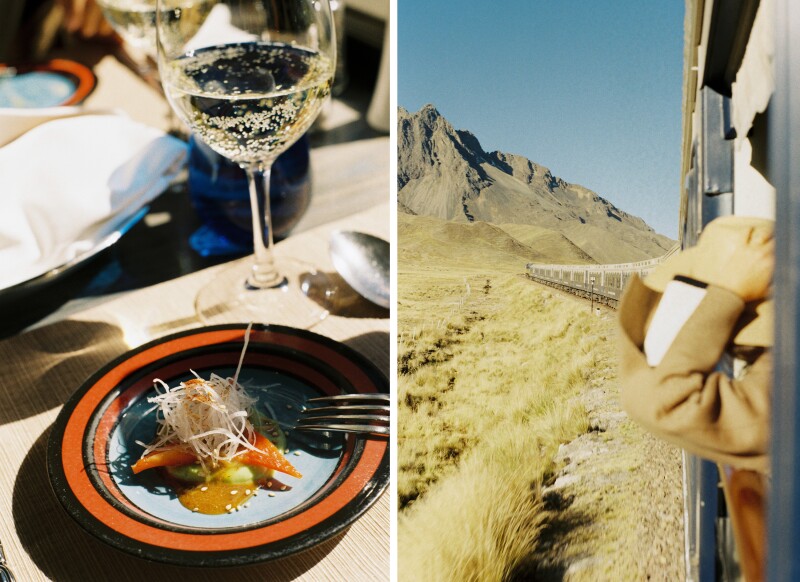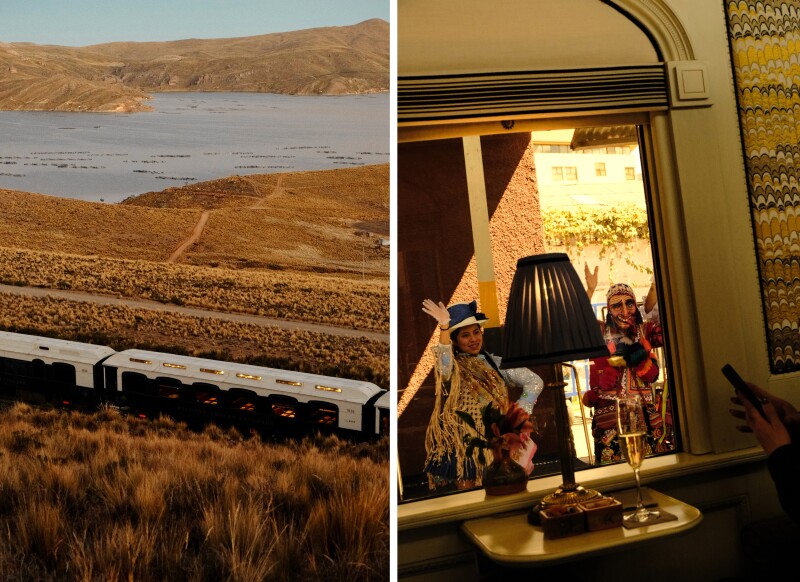By the time I arrived in Cusco to board the Andean Explorer, a Belmond Train, South America’s first luxury sleeper train, I was ready to be spoiled. It had been 12 days since I’d first arrived in Peru to explore its reaches; 8 days since I’d landed in the Amazon, where I swam in snake-infested waters and had gone 4 days without showering; 3 days since a 12-hour wedding that I was only beginning to recover from. Now, it was 10 in the morning in May, and I was sitting in a waiting hall, a drink of chicha morada (purple corn) in hand. My passport and ticket had already been checked; my bags whisked away.
Outside, the gleaming train glistened royal blue and cream, with Belmond Andean Explorer shining in silver on the side. Belmond employees, clad in crisp white shirts and tan jackets and slacks, hustled on and off the train, transporting luggage, flowers, and last-minute supplies that would accompany us on our overnight trip southeast to Lake Titicaca, the world’s highest navigable lake, at 12,500 feet.
Before we took off, though, the journey would need to be blessed. Outside the waiting hall, three dancers did just that, and at 10:55, we were invited to board the train. Staff directed me to the lounge with several other guests to hear all about the journey before being taken to my room. Within seconds of sitting down, a beaming waiter appeared, offering me a glass of champagne and two small bowls of nuts and dried fruit. I settled back in my chair as the train tooted and began its slow, steady chug away from the station. The spoiling had begun.

Fine dining, expert waiters who don’t spill a drop, and memorable views are all part of the experience.
Courtesy of Andean Explorer, A Belmond Train, Peru
Though today it is owned and operated by PeruRail, the Andean Explorer began its life on another continent: From 1999 to 2003, the train was the Great South Pacific Express, often called Australia’s “Orient Express” for its journey along the eastern seaboard of the country. In February of 2016, it was shipped to Peru, where it was given a complete refurbishment, although the bones—two dining and bar cars, an open-air observation deck in the caboose, and accommodations with double, twin, and bunk beds—were kept. Today, it operates four journeys ranging from one to two nights, with prices beginning at $3,238 for single occupancy.
For navigation purposes, each of the public-facing cars was given a name, most in Quechua, an Indigenous language native to central Peru: the piano bar car is macha (a type of root vegetable), the observation car is ichu (Peruvian feathergrass), and the spa is picaflor (hummingbird in Spanish). My sleeping car is tara, a species of small tree. After finishing the orientation and my glass of champagne, I followed an attendant down the slightly rocking hallways to my cabin.
The space was small but well-appointed. A leather couch—which will later be turned into my bed—faced a wide window, and a plush leather chair sat parallel to the window, with a cushion for my feet below. I sat down and opened the shades and watched the countryside rumble by: lush fields with farmers pausing to wave, vertiginous peaks with paths that stretched beyond my eyesight. Before long, it was time to return to the bar car for lunch: lip-puckeringly tart ceviche with slivers of red onion and crunchy Peruvian corn, which wobbled only slightly on the table.
After eating, I stepped outside to the outdoor observation car, which offered 360-views of the countryside. The train clicked parallel to the winding Huantay River, and the other passengers and I politely shared the best real estate: when the train curved around bends and seemed to almost double back on itself as it climbed to higher plains. Alpacas in fields paused their chewing to watch us pass by, and farmers worked in the sun.
Three and a half hours in, we stopped at Raqchi, an ancient Inca site that has 152 remarkably intact mounded storage facilities (once used for housing corn and quinoa) lined in rows and the prominent Temple of Wiracocha, which stands 302 feet tall. Prior to boarding the Andean Explorer, I’d never heard of Raqchi, but as our guide pointed out how its intentional design would make visitors walk in a zigzag motion—and how that design reflects elements of Incan cosmology—I considered how little I’d known about Incan history outside of Machu Picchu. How thankful I am that this trip afforded me such a luxury of a different kind.
Back aboard, it was time for yet another kind of luxury: a massage. I changed into a robe and slippers and padded down to the spa car, where I selected an Andean mint oil for my treatment and lay face-down. The massage therapist dug into my back and as the train creaked and cranked along, I fell into a deep sleep, my last thought being, I should really look out the window.

Belmond’s Lake Titicaca trip is also offered as a two-night New Year’s Eve experience.
Courtesy of Andean Explorer, A Belmond Train, Peru
The sun had mostly set during my massage, but some light was still visible when we stopped again at 5:45 at the highest point in our journey. We disembarked and walked a few minutes up an easy slope to take in the view beyond the train: the La Raya mountain range, in the Peruvian Andes, snow-capped at 14,000 feet. There was no source of light save for the glow of the train and the sunset, which reflected off the carriages and made the cars look an incredible golden blue. The tableau was almost something out of a Wes Anderson movie. I snapped a few photos dutifully but otherwise stood in silence, looking at the mountains, appreciating that this is not a moment I would ever have anywhere else again.
Nor, probably, was dining at such great heights. I dressed for dinner in a blazer and slacks and moseyed on down to the piano lounge, where a crowd—most traveling in small groups, mostly from Australia, China, and the U.K.—had gathered for cocktail hour. Despite a custom pisco cocktail on offer—remembering that 12-hour wedding celebration—I opted instead for a gin and tonic made with Gin’ca, a Peruvian dry gin made with flavors of pink peppercorn, marigold, lemon verbena, and lime. One of the bartenders, César, had earlier let me try the gin after I noticed the bottle on the shelf.
Dinner itself was anything but a simple affair: tablecloths had been ironed, napkins carefully curled into their rings, candles placed in glass holders, wine glasses set just so. Two fellow travelers, retirees Charles and Kathy from Sydney, Australia, invited me to join them for the meal, and as we sat in curved leather chairs, suited waiters navigated the narrow, rocking hallway, holding drink trays with the grace of ballerinas.
Over cured trout in chestnut milk and suckling pig with green apple puree, we talked about travels, mine and theirs. While my trip was winding down, and I would fly back home to New York in a day’s time, they were only halfway through their journey around South America; next, they would fly to Brazil. Despite the differences, we agreed that this train journey has been a highlight, no matter what awaits.
After dinner, I took one more walk to the end of the train, where I found I had the observation deck to myself. I slid open the doors onto the platform and stepped out, the wind whipping my hair and the night’s chill cutting through my clothes. Still, I lingered. I leaned back on the railing and looked up at the sky, a black forest dotted with stars.
It is almost as dark the next morning at 5, when I woke to join a few other passengers for a sunrise viewing over Lake Titicaca, which we reached late in the night. The largest freshwater lake in the world, Titicaca is also reportedly the birthplace of the Incas. I stepped down off the train and walked a few short paces to its edge. As the sun poked its head up over the horizon and the light spread slowly, I thought of standing in a place that has held such significance for centuries and that will continue to exist, long after I’m gone.











